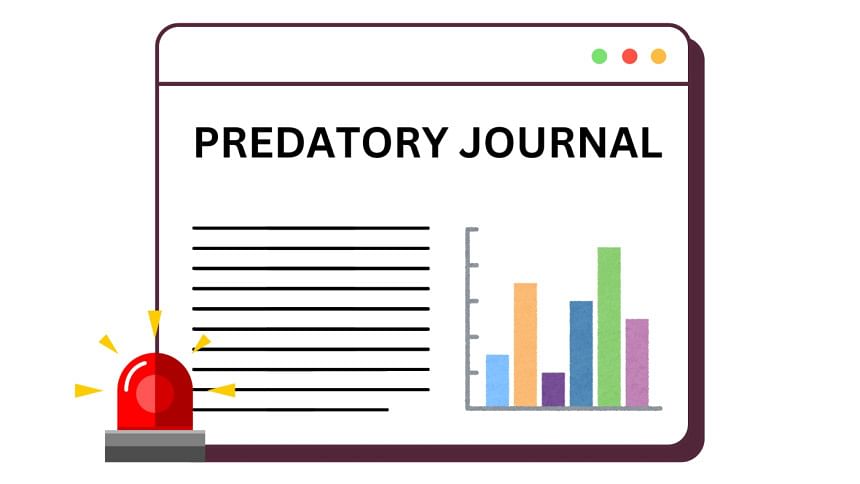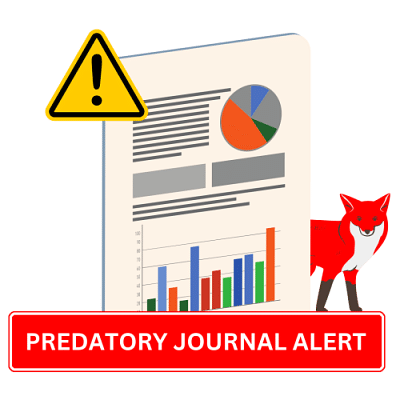Imagine yourself in the position of a prospective academic, conducting research in your field of interest. The best – in fact, the only – way to grow in the world of academia is through having your work published. However, researchers often have to deal with the crushing anxiety that arises over not publishing as frequently, facing rejections, and looking out for conferences and journals to submit their work. All of this is most certainly not easy work. Moreover, it's very easy for young researchers to be completely overwhelmed by the sheer amount of patience and sustained effort it can take to have their names published even once. This is where the pitfall of predatory publishing comes in – a devastating scam that many junior researchers have fallen for.
What is a predatory publication or journal?
To understand how exactly a predatory journal functions, let's try to understand how academic publishing works in the first place. "Peer-reviewed" is a term that many may be familiar with – in academia, this serves as the bread and butter for all things that deal with research.
According to Dr Md Kabir Uddin, an assistant professor at North South University's Department of Biochemistry and Microbiology, "For our research work to hold any merit, it must undergo a thorough review process before it is considered for publication. Predatory journals are dangerous because they are not reputed or considered by any scientist to hold any value. The biggest reason behind this is that these journals will provide no peer-review on your work, and sometimes they go as far as to publish falsified or doctored data under the guise of having done some 'research' work."
The quality of the journal matters to academic institutions. The same applies to questionable conferences. It is much better for students to take the time to have their work featured in more respected and legitimate scholarly venues. This is a case where less is more. It is better to have less work published or featured in more notable outlets than it is to have a great deal of work published or featured in questionable outlets.
Mahir Amer, a master's student in Biological Sciences at the University of Edinburg, further elaborates, "A lot of faculties or researchers receive unsolicited emails asking them if they'd like to submit papers. These journals often have some major red flags that are pretty easily distinguishable if you spend some time in academia. Journals that publish on topics that have nothing to do with each other, exorbitant processing charges, and misleading claims about legitimacy are all indicators."
Similar sentiments are echoed by Dr Mahbubul H Siddiqee, an associate professor of Microbiology at BRAC University, who goes on to paint an image of how predatory journals plague researchers, specifically in Bangladesh. "A big portion of mainly young researchers in our country have had some dealings with predatory journals. A whole lot of these cases do not occur by accident, as many researchers are driven by this 'publish-or-perish' culture that permeates academia today," he lamented, highlighting a core issue of how research is perceived in the country.

Why do students and researchers submit their work to predatory publications?
According to a study by Umme Habiba and SM Zabed Ahmed, over 79 percent of participants admitted that the rapid acceptance and publication time provided by predatory journals might be a motivating factor for researchers to submit their work in these spaces. But why would any researcher care for that? The answer comes from Dr Mahbubul who says, "Young faculty members looking to make their CVs heavy will definitely make use of this – especially because many universities in Bangladesh don't have strict restrictions against hiring researchers who have published their work in these predatory journals. Many lecturers and assistant professors also use these to increase their publication rate as a means of obtaining promotions as universities in our country have particular criteria that are concerned about the number of publications one makes over the quality of their publication."
I see no issue with students getting published in such publications, at least during their undergraduate studies. In most cases, students aren't aware of or don't have much knowledge of the journal communities or industry. During their postgraduate or doctoral education, this is viewed differently. During these times, the publication and reputation of the journal are reviewed better.
The impact of getting published in a predatory journal
It is evident, thus, that a lack of awareness and general apathy regarding research work has led to this practice being far more commonplace than it has any right to be. It is true that no matter your field, conducting research in a resource-strained country like Bangladesh can disillusion even the brightest minds. The appeal of these predatory journals begins here. Complete with deceitful indexing information and false claims to scope, these journals are often sought out by researchers for the sake of boosting their own reputation in the eyes of others – not realising the damage it causes to their name as a researcher on an international stage. Published research, after all, is scrutinised thoroughly by academics across the world.
Dr Nneka Logan, an associate professor at the School of Communication at Virginia Tech University, reflects on this, "The quality of the journal matters to academic institutions. The same applies to questionable conferences. It is much better for students to take the time to have their work featured in more respected and legitimate scholarly venues. This is a case where less is more. It is better to have less work published or featured in more notable outlets than it is to have a great deal of work published or featured in questionable outlets."
Undergraduate students looking to enter academia, be it in the sciences or humanities, certainly have their work cut out for them. When playing on an international stage, as researchers so often do, it is important to rigorously understand how academic publications work. And while there is a definite group of people who are apathetic towards publishing in high-impact journals, one thing that also requires discussion here is the lack of knowledge that plagues researchers in Bangladesh regarding predatory journals.
In the study by Habiba and Ahmed, it was suggested that many of the participants were simply confused by the terminology of "predatory publication". Nearly half of these participants, the majority of whom were assistant professors, did not feel confident enough to assess a journal's quality all by themselves. This poses an issue that is institutional in nature, and as such has to be dismantled from the ground up.
University students, despite not necessarily being in charge of what research is being carried out, have a massive role to play here. After all, these are the same people who will eventually take on the roles of professors and researchers. If – through cultural diffusion – their perception of research is altered to favour predatory publishing, then where does that put us? And if these students are accidental victims of having their work printed in a predatory journal, then what implications does that have for their future?
To this end, Dr -Ing Ulrich Vogt, Head of the Department of Flue Gas Cleaning and Air Quality Control at the University of Stuttgart, offers a sliver of hope. "I see no issue with students getting published in such publications, at least during their undergraduate studies. In most cases, students aren't aware of or don't have much knowledge of the journal communities or industry," he claimed.
"During their postgraduate or doctoral education, this is viewed differently. During these times, the publication and reputation of the journal are reviewed better," he added.
While undergraduate students may have some leeway in this case, it is clear that beyond this boundary, publication in a predatory journal can come with serious repercussions. The lack of awareness, which seems to be a pervading issue, has to be addressed within every respective university. Additionally, there is also a subculture that thrives on 'quick and dirty' work as future repercussions aren't considered. It is imperative for university students and young academics to be keenly aware of both sides of the problem, and to establish programmes that allow these problems to come to light.
Reference:
Understanding and Mitigating the Menace of Predatory Journals: Perspectives of University Teachers in Bangladesh. Habiba, U., Ahmed, S.M.Z. https://doi.org/10.1007/s10805-024-09538-3
Raian is a poet, a final-year student of Biochemistry, and a contributor to The Daily Star.
How to identify predatory journals - as explained by University of Arizona

- The journal promises quick publication.
- No International Standard Serial Number (ISSN).
- Not indexed by MEDLINE, Scopus, PsycINFO, Web of Science, or other legitimate abstracting or indexing services or databases.
- The journal lacks clear policies on retraction, corrections, or plagiarism.
- Predatory journals lack description of the manuscript handling process.
- Manuscripts are requested to be submitted by email instead of through an online submission system.
- Journals claiming to be open access either retain copyright of published research or fail to mention copyright.
- Article processing and/or publication fee is very low, for instance, less than USD 150.
- Information on whether and how journal content will be archived and preserved is absent.
- Scope of journal is not clear.
- Journal's website contains spelling and grammatical errors.
- Journal is not published by reputable or known publisher.

Indicators that a journal or publisher is not predatory
- Scope of the journal is well-defined and clearly stated.
- Journal's primary audience is researchers or practitioners.
- Journal's editor and editorial board are recognised experts in the field.
- The journal is affiliated with or sponsored by an established scholarly society or academic institution.
- Any fees or charges for publishing in the journal are easily found on the journal web site and clearly explained.
- Journal clearly indicates rights for use and re-use of content at article level.
- Publisher is a member of Open Access Scholarly Publishers Association.
- Journal is registered in UlrichsWeb Global Serials Directory.
- Journal is listed in the Directory of Open Access Journals.
- Journal is included in legitimate abstracting or indexing services or databases such MEDLINE, Scopus, PsycINFO, and Web of Science.








Comments